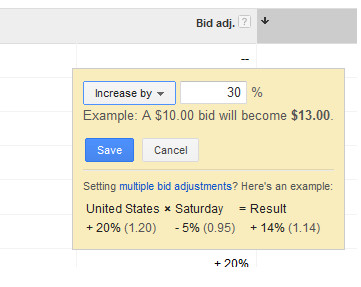Location Targeting with New AdWords Enhanced Campaigns for Retailers

Before Google’s new Enhanced Campaigns, targeting your ecommerce AdWords campaigns to specific locations was an on/off proposition. Basically, if you determined that Michigan performed differently than Florida, you needed to duplicate your campaigns: one for Michigan and one for Florida.
Only this rarely ever occurs in real life. Campaigns house so much administrative overhead (ad groups, keywords, bids, ads) that it hasn’t been very pragmatic to duplicate campaigns 50 different ways to take advantage of conversion rate variations by location.
Enter Enhanced Campaigns.
Enhanced campaigns could more fully be named “Mobile Enhanced Campaigns”. Starting now and culminating in June, mobile device targeting is being combined with desktop & tablet targeting within a campaign. There will no longer be an option to target mobile devices on their own. Instead, advertisers are being directed to rethink their targeting as user-centric… these same users simply happen to be on different devices throughout the day.
Yet, to achieve the mobile goal, Google had to add additional functionality specific to locations. Advertisers need fine-tuned location targeting.
Google has delivered.
For ecommerce advertisers, enhanced location targeting is the secret power of new Enhanced Campaigns. Instead of locations being a “on/off” selections, Google now allows location targeting to be set as a percentage of your standard PPC bid.
If you sell seasonal products that are dependent upon weather or geographic features (such as proximity to the ocean), new location targeting will probably increase the efficiency of your campaigns by at least 10%. Within a single campaign, you can literally change your bids depending on the individual’s weather.
Within the United States, this bid-aware location targeting is available all the way down the the zip code level.
If you sell general-use merchandise or clothing, you may think such location-specific targeting isn’t necessary. After all, you regularly sell in all 50 states and perhaps a few other countries. Yet have you ever taken a look at your conversion rate and CPA by location? You’ll be surprised to discover the ROI disparity among seemingly similar states, cities, and regions.
Before, there wasn’t much you could do about this, short of duplicating your campaigns. Even that isn’t scalable — the most astute advertisers would only cherry-pick the top one or two outliers for this special treatment.
Now everyone can fine-tune their location targeting by adding bid multipliers from -90% to +900% to most any location. If Detroit under-performs Des Moines by 10%, lower Detroit’s bid by 10% (or maybe increase the bid in Des Moines). Retailers with physical stores can also use proximity bidding to increase/decrease bids within a custom radius around their locations.
You’ve been handed an advertising gift. Use it!
Sadly, unlike Yahoo/Bing, Google’s ad scheduling still isn’t timezone-aware. All ad scheduling is tied to the AdWords account timezone. So there still isn’t a way to increase bids between 6-7pm in the user’s timezone short of duplicating campaigns. Maybe this will be next?
Tagged Enhanced Campaigns






